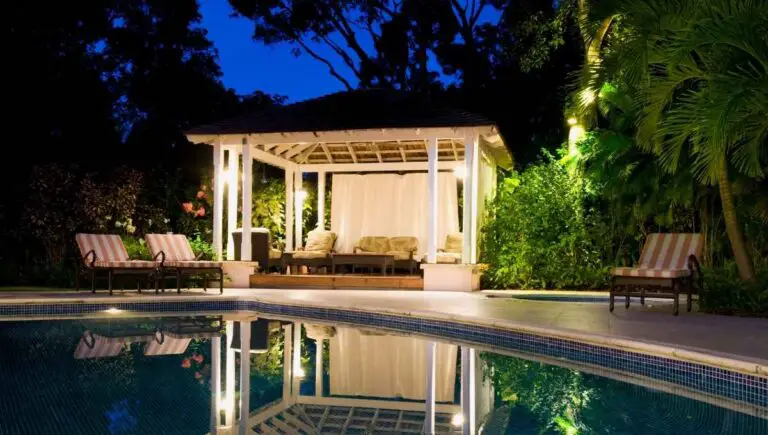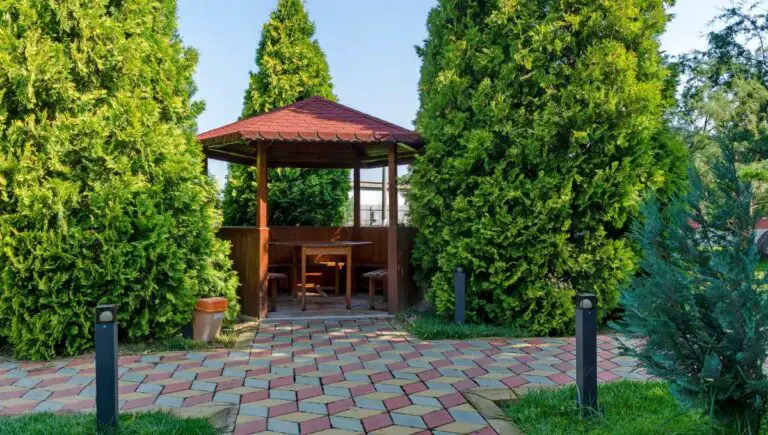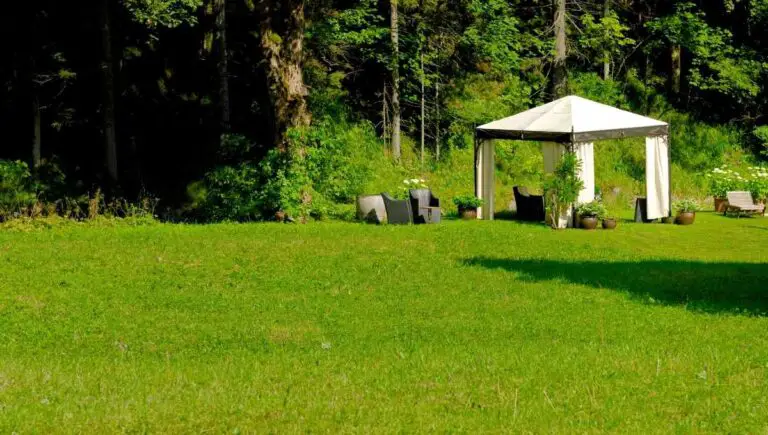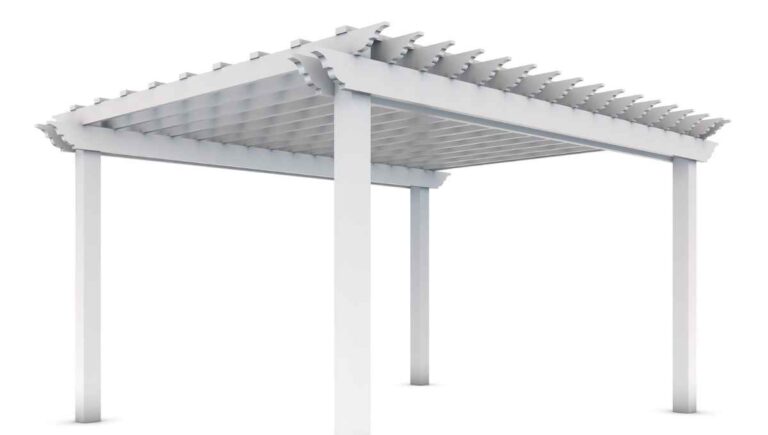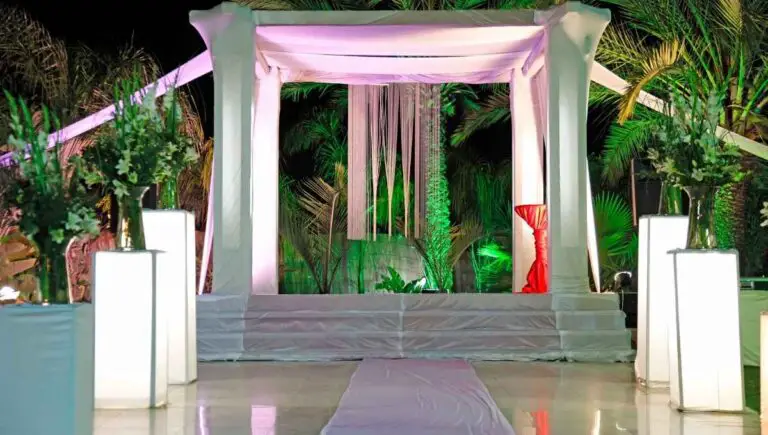Are Gazebos Waterproof? (How to Protect Yours From Rain)
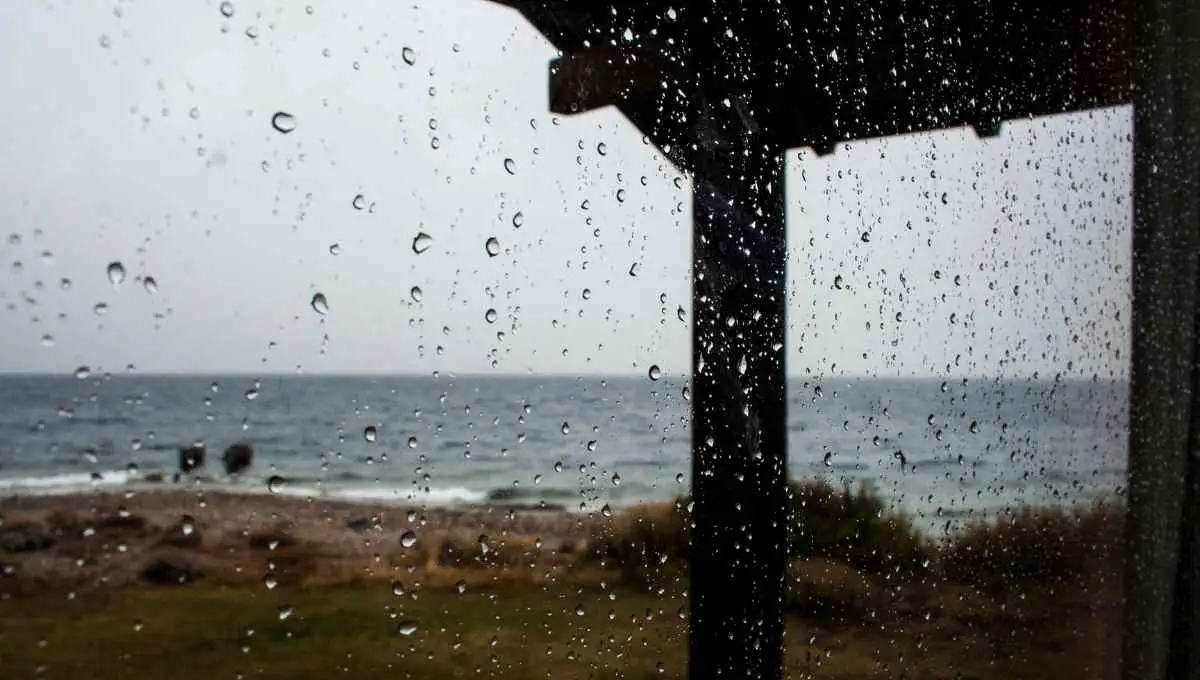
Gazebos are a fun and innovative addition to your yard that can help you enjoy the relaxation of breezy, sunny days without suffering any type of sunburn. However, can they protect us from rain, and are they waterproof?
Whether or not a gazebo is waterproof depends on the type of gazebo you have. Some gazebos are designed to be waterproof, while others are only water-resistant. It’s important to consider the level of protection you need when choosing a gazebo for your backyard.
Gazebos don’t have to be hard to figure out. In this article, we’ll speak about how to best waterproof your gazebo, what can you do to protect and maintain it, and what can you use to cover your gazebo canopy from heavy rains.
This post contains affiliate links from Amazon and other stores. This means Yard Blogger may earn a commission if you make a purchase using any of our links. Please refer to our full affiliate disclosure policy for full details.
Here’s a Quick Pro Tip!
Many gazebos come with a PVC layer that is meant to waterproof them, but this may wear off easily if the weather conditions shift drastically around your city. For this reason, you should get a waterproofing spray, or apply another type of waterproof layer to protect your gazebo.
We think you may need these tools to be able to waterproof your gazebo efficiently:
1. STAR BRITE Waterproofing Spray– Protects from sun, rain, and UV-Rays.
2. Odorless Mineral Spirits – It works for many purposes. However, for the sake of waterproofing your gazebo, you need to mix this product with a strong sealant to be able to add a coat to the canopy.
3. Waterproofing Sealant – Mix this product with mineral spirits to add a layer of protection to your gazebo or canopy. This can also work for other outdoor and indoor structures. So, you’d have all the benefits!
Rain Concerns
Gazebos can cover us from the sun, but what about the rain? There are amazing tools we can use to protect our gazebos from weather turbulences. Let’s talk about how waterproof a gazebo can be.
How Waterproof Is a Gazebo?
A gazebo can be as waterproof as its components allow it to be, but, in general, they are not viewed as water-resistant. The reason for this is that most gazebos still have a risk of having water sweep through them, if not sealed correctly.
A gazebo’s waterproof capacity depends on the material it is built with. For example, fabric or canvas gazebos, usually meant for temporary purposes, don’t tend to be much waterproof. Although, they can protect someone from rain temporarily.
But, they are not necessarily meant to be used under harsh weather. For you to be able to waterproof these types of gazebos, you’d have to buy a waterproofing spray or sealant that can allow you to prepare it for these conditions.
Otherwise, your fabric gazebo won’t tolerate the rain and even create puddles in the canopy. On another note, this can change if your gazebo is made with wood or metal.
Metal gazebos are likely to be waterproof by default, although they should still be protected to prevent rusting. In the case of wood, you have to use a sealant (or other waterproofing methods) so it doesn’t rot due to exposure to water.
How Do You Cover a Gazebo in the Rain?
You can cover a gazebo in the rain by using waterproof covers, or a tarp, or you can install wood roofing over your gazebo to protect it from rain. The latter is not very common, yet still helpful.
You can choose to use these covers for each side of the gazebo, or just buy one big cover for the entire gazebo. The latter is harder to install and remove, but it is worth the try. However, if neither of these options convinces you, you can also use a tarp for your gazebo’s canopy.
How to Protect a Gazebo From Rainfall?
You can protect your gazebo from heavy rainfall by waterproofing it on a bright, sunny day, or you can choose to cover your gazebo with a specialized canopy cover that is meant to protect it from such weather conditions.
There are many gazebo covers available online, with many different colors, sizes, and designs. You can choose one that works to protect your gazebo from the rain, and even add some type of aesthetic to your garden or patio while the weather turbulence pass.
However, if you have a canvas or fabric canopy, you can choose to buy a waterproofing spray designed to help you make your gazebo or canopy water-resistant. All you have to do is take it off the gazebo and spray this solution on both sides of the canopy.
Make sure to do it on a sunny, dry day. Otherwise, you risk not covering up the entire canopy, and consequently, you’ll have non-waterproofed spaces on the top of the gazebo.
Are Canvas Gazebos Waterproof?
Canvas gazebos are not waterproof because they are made with natural fibers, such as cotton or hemp, which are commonly known for absorbing water. Thus, someone would have to waterproof them to protect them from the weather.
Since these natural fibers absorb and soak up water, they are unlikely to protect anyone from getting wet under the rain. It becomes a worst-case scenario if you use your canopy for outdoor events that require extra precaution in this regard.
Thus, the best way to use a canvas-made gazebo is by waterproofing it with a spray designed for that. Since these fibers are fragile, extra measurements should be taken to make sure they are waterproof. If you have to use a cover to do so, by all means, don’t hesitate to get one.
Waterproofing
Gazebos can be damaged by the rain if they are not protected adequately. So, to avoid this, you have to learn how to best protect it from rain. Let’s talk about all of these things below.
Do Gazebos Leak?
Gazebos are prone to leakage, and the way to resolve this matter is by using a sealant in the corners of the canopy and around its stitches. It is around these places where your gazebo is likely to leak the most.
If you don’t fix this issue immediately, your gazebo might suffer unrepairable damages. This means that you’d likely need to buy a new one, so make sure to get that sealant before things become hard to fix.
How Do You Stop a Gazebo From Taking Water Damage?
You can stop a gazebo from taking water damage by maintaining it on a constant basis, which also includes waterproofing the canopy regularly to avoid it from becoming unstable and deemed useless.
Generally, when choosing a gazebo, you should ensure that the material it is made with isn’t of bad quality. Bad-quality gazebos don’t tend to last as much as high-quality gazebos, so making the right choice can influence how long your canopy lasts.
Now, once you have your gazebo, you should create a cleaning schedule for it. Gazebos are high-maintenance patio structures, which means you will have to tend and take care of them regularly.
If you clean it constantly, you have to also waterproof it constantly. One cannot go without the other. This is especially true in a case where your canopy is already waterproof. Generally, these water resistance mechanisms don’t last long and can wear off if not treated properly.
Therefore, cleaning and waterproofing them responsibly are the keys to keeping your canopy intact and risk-free. You won’t only ensure that it won’t suffer any more water damage but will also last longer.
You might also enjoy our post on If Gazebos are Safe in the Wind
How Do You Waterproof a Gazebo Top?
You’ll need to use a waterproofing spray or other waterproofing remedies to be able to protect the gazebo top from suffering water damage. However, you can also use waterproof tarps or gazebo covers to ease this process.
If your canopy is made out of canvas, you’ll likely need to mix mineral spirits with silicone, then use a roller to “paint” the gazebo top after taking it off of the gazebo frame. The quantity of the product you need will highly depend on how large your gazebo is.
But before doing this, remember that you first have to clean the gazebo and let it dry. It is more convenient to do this on a sunny day to accelerate the process. Yet, if this is not possible, hang the canopy on a clothesline somewhere dry.
You can also waterproof the top of the gazebo using waterproofing spray, although you’ll have to be more careful when applying it. It is recommended to avoid doing it on windy days because it can affect the application process and not cover the whole top entirely.
Nevertheless, it can also vary if your gazebo is made of wooden materials. In this case, you’ll need a wood sealant to be able to do it. Due to the nature of the process, it may take longer.
Even then, if you don’t want to spend so much time waterproofing your gazebo, you can use a gazebo cover that you can quickly get online. Just make sure to choose the right size for your gazebo, and you’ll be ready to go.
Are Gazebo Tents Waterproof?
Although many gazebo tents can be waterproof, the truth is that not all tents are water-resistant because of the fabrics they can be made with. An example of a non-weather-resistant fabric is cotton, which can absorb water.
However, polyurethane fabrics (another variation of polyester) have incredible water-resisting capacities. These types of gazebo tents tend to be waterproof, but only for a short time. You’d have to apply waterproofing spray on them regularly to keep them waterproof.
One of the most clever things you can do to keep your tent waterproof is by using a canopy cover you can get online. Additionally, you can choose the color that best matches your canopy to improve aesthetics. But, don’t underestimate the importance of quality when buying.
How Can I Make My Wooden Gazebo Waterproof?
You can make your wooden gazebo waterproof by using a wood sealant to cover all the compromising parts of your wooden structure. To do this, you need regular painting tools to be able to cover the larger sections.
It’s recommended to put the sealer on a painting pan, then proceed to cover the ceiling of the gazebo first. Ensure to protect the floor before beginning, as you don’t want any weird spots on it.
Then, you’ll need to get the bigger areas with a roller and proceed with the smaller areas using a regular paintbrush. You have to make sure to reach out to the most difficult corners of the gazebo and all other spots where the leakage is likely to occur.
Additionally, using oil paint for wooden structures will ensure their longevity. This is possible because the oil-based paint protects the wood from external humidity, decreasing the chances of rotting wood.
Are Polyester Gazebos Waterproof?
Even though polyester gazebos tend to be more water-resistant, they are not always waterproof, as they still have a risk of having water sweeping through the canopy. For this to not happen, it needs to be waterproofed by having an extra layer of PVC.
And even then, if the polyester canopy isn’t thick enough, it’ll likely absorb water and cause it to become damp. Yet, polyurethane does have water-resisting properties. So, you may search for a gazebo made with this type of polyester variation.
You might also enjoy our post on If Gazebos Are Safe During Lightning
Correct Gazebo Protection
Your gazebo is prone to water damage, so you must waterproof it. However, this is not the only way you can protect your gazebo from damage. Let’s talk about how to protect your gazebo below.
How Do I Protect My Gazebo?
Protecting your gazebo requires that you clean, maintain, and secure it constantly so that it does not suffer any damage caused by weather changes. To secure it, you have to use weights, and to waterproof it you have to use a spray.
If you don’t ensure that your gazebo is firm on the ground by using weights or sandbags, you are in for a surprise. A gazebo canopy can fly off during high winds and other harsh weather. Likewise, if you don’t waterproof your gazebo, it can suffer from water damage.
So, protecting your gazebo is an all-encompassing thing. It also includes cleaning the canopy regularly. In the case of wood and other hard materials, waterproofing and inspecting it constantly to detect rotting woods or rust can help you avoid unwanted incidents.
How Do You Put Gutters on a Gazebo?
You put gutters on a gazebo by first measuring the edges of the gazebo, then buying the pieces you need to later attach them to the gazebo with a drill and some screws. Once attached, you have to install a downspout to drift the water away from the gazebo.
It seems like a simple task but can become complicated if not done well. Here are a couple of things to keep in mind when installing gutters on a gazebo:
- Measurements are important. The measurements will help you determine how many gutters you need and how much should you cut to meet the size of the gazebo. If you don’t do this carefully, you risk making an unrepairable mistake.
- You’ll likely need to adjust the size of the gutters. Some gutters won’t come in a specific size destined for one type of gazebo, so you’ll likely need to cut them down to match your gazebo’s size. You can cut them with a saw to make them fit your gazebo.
- When installing, you should leave spaces between the gutters. At least ½ of an inch should be left between the corners of the gutters. When installing, leave the corner edges of the gazebo for last.
- You must have the right tools. You are likely to need a drill, screws, nails, and even brackets for better gutter support. You’ll also need a special saw that can help you cut down the gutters before officially attaching them to the gazebo.
- Don’t underestimate the need for a downspout. This is optional, but if you really want to drive water away from your gazebo, you need a downspout. It should be installed in a way that leads water away from the structure, and the house.
Now, the method for attaching the gutters is relatively simple. However, the process may vary depending on your gazebo’s size and structure. We recommend that you also revise the manufacturer’s manual for more details about how to install gutters.
How Do You Keep Water From Pooling on a Canopy?
To keep water from pooling on a canopy, you’d have to eliminate the slack that is causing it by using a hula hoop or a pool noodle. You have to place them in the corners of the gazebo where the slacks are, and make sure they are firm.
With pool noodles, you just have to add them inside the corners of the canopy and try to shape them like an arc. It will keep that part of the canopy up and straight, so any water that may fall on top of it will slide instead of standing there.
What Is the Best Waterproofing Spray for a Gazebo?
The best waterproofing sprays for a gazebo are from the KIWI and STAR BRITE brands, which offer both sun and waterproof protection. You can get waterproofing sprays, belonging to these brands, online.
Here are our favorite waterproofing sprays:
- KIWI Water Repellent
- KIWI Water and Stain Protecting Spray
- Kiwi Camp Dry Heavy Duty Waterproofing Spray
- STAR BRITE Water Proofer
- STAR BRITE Xtreme Protectant
Is There a Waterproof Pop-up Gazebo?
There are waterproof pop-up gazebos that you can use for temporary events, like weddings or regular birthday parties. Yet, their integrated waterproof coat can wear off after some use, so it’s important that you still consider using a spray to protect them.
Many pop-up gazebos already come with a waterproof mechanism, like PVC layering. Mostly, they are made with polyester and tend to be built in a way that prevents slack so that water does not pool on the canopy.
But, it’s not always reliable, and you’d still have to manually waterproof them in many instances. This is highly influenced by the quality of the canopy. The lower the quality, the less waterproof it tends to be.
Canopy Concerns
Regular built-in gazebos can require you to waterproof them by using a spray, or a sealant. However, when it comes to gazebo canopies, there are other things you have to pay attention to so they can last longer. Let’s discuss this below.
How Long Does a Gazebo Canopy Last?
Depending on the type of canopy and gazebo material, a canopy can easily last up to 15 years if it’s maintained properly, according to all the recommendations the manufacturer or gazebo experts set.
However, the quality and type of gazebo can change this estimate. For example, a pop-up gazebo’s canopy is meant to last around 6 years, although you can make it last longer if you waterproof it responsibly.
Hardtop gazebo canopies, on the other hand, are meant to last around ten to 15 years. This is especially true when it comes to polyester sheets, and so on.
How Do I Protect My Gazebo Canopy?
You must maintain a solid cleaning and waterproofing schedule for your canopy. On average, you should waterproof your canopy every two to three months, to ensure that everything is in order.
You can use waterproofing spray for your canopy, or a sealant coat mixed with mineral spirits. Each application is different, so you should consult with an expert that can guide you in the process.
How Do You Waterproof a Canvas Pop-up?
You can choose one of two methods to waterproof a canvas pop-up: a waterproofing spray or a solution of mineral spirits with sealant. You need to wash your canvas canopy before waterproofing to ensure that everything sets well.
You also have to let the canopy dry well, and you should apply the waterproofing method to both sides of the canopy. Try to do it outdoors, in an open space, and on a day with low wind and low chances of rain. These factors will help you fasten the process.
You might also enjoy our post on If Gazebos Can Be Used as a Carport
How Long Do Canvas Gazebos Last?
Canvas gazebos tend to last around three years, if not maintained appropriately, but can last longer if the owner treated their canopy with care. If you plan to choose a canvas gazebo, make sure to clean and waterproof it to make it last longer.
Yet, you should keep in mind one thing. Although there are many sprays and solutions to waterproof your gazebo, you must find one that works for your current case scenario. Not all waterproofing sprays work for all types of gazebos, so you should check them well.
The thicker the fabric, the less likely it is to absorb the waterproofing spray. In this case, you should be able to find a sealant that can cover your canopy without much effort.
Related Questions
Why Do Gazebos Have Holes?
The reason why gazebos have holes is so that water can drain through them without damaging the canopy. This also prevents water pooling, which can create permanent damage to the canopy and make you need to get a new one.
Water pools on the canopy will likely weaken the spot where the slack is, and it can break and soak anyone underneath. Thus, it’s important to prevent this by buying a canopy with an anti-slack mechanism or using pool noodles to avoid them.
Can a Gazebo Protect You From Rain?
Wooden, polyester, metal, and concrete gazebos can protect you from rain, unlike canvas gazebos or other similar fabrics. However, wood can only protect you if it’s treated or if it’s waterproof by default.
Some types of wood don’t always protect you from rain, which is why it is important to waterproof wooden gazebos. It does not only protect the wood from mold, but it also makes sure that no water can sweep through.
Additionally, canvas gazebos could protect you from rain, but only if they’re treated with a waterproofing spray. If you have one of these gazebos, you can shop for a waterproofing spray online to save you stress.
Do Gazebos Keep You Dry?
When raining, gazebos can temporarily keep you dry, especially if they’re waterproofed, which is why most people rely on them when walking through gardens or parks. However, not all gazebos can do this.
Some canvas-made gazebos can’t keep you dry because water can sweep through them. Others may have standing water on their canopies, which can become a problem if it causes the fabric to yield and break.
If this happens, someone will get soaked with water (hopefully, not you). This may seem funny at first, but it isn’t. Standing water can be a hazard if left for long periods, so you should ensure to avoid having it near or around your canopy.
Final Thoughts
Many gazebos can come with waterproofing coats, but not all of the last for long. Thus, manually cleaning and waterproofing a gazebo is important to ensure its longevity and quality.
For wooden and metal structures, waterproofing them with sealant is your best go-to. Even though they may protect you from the rain without needing the sealant, it’s best to protect them so that the material doesn’t rot or rust.
Additionally, always make sure to pay attention to the quality of the material your gazebo is made with. There are many options you can choose from out there, but not all are authentic. Hence, you should be extra cautious when choosing a gazebo for your yard.














